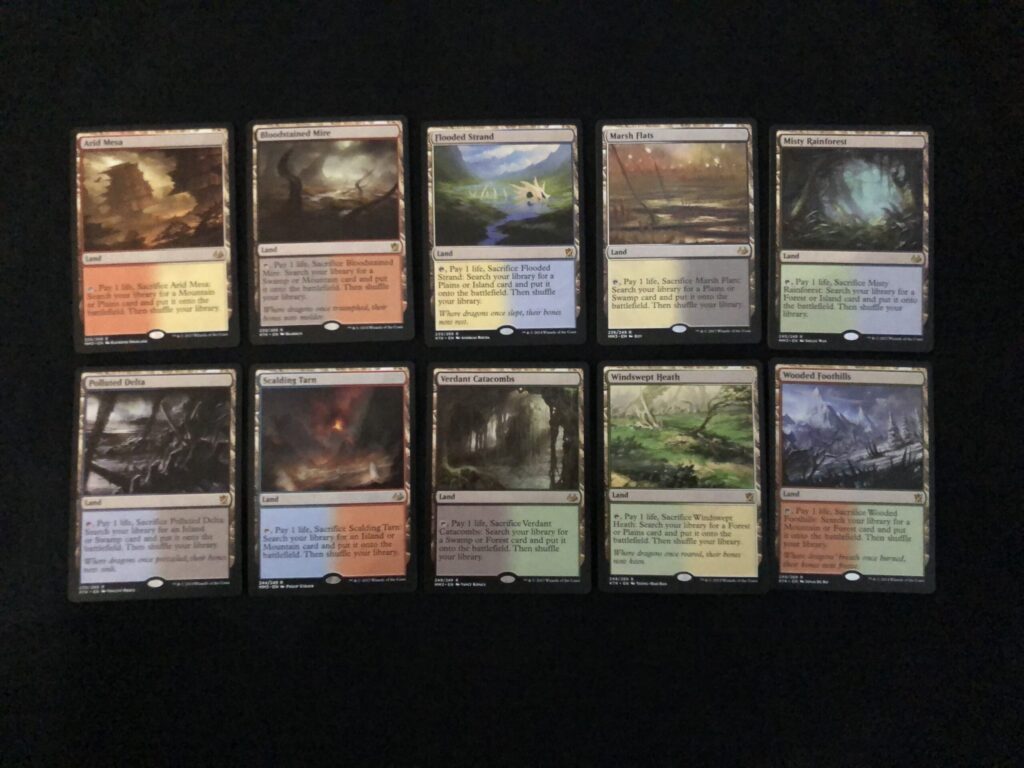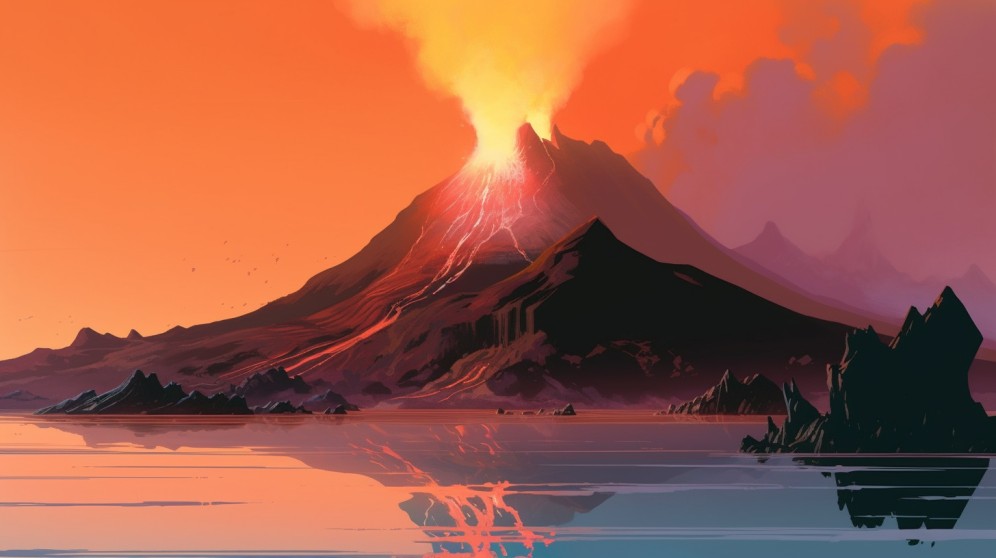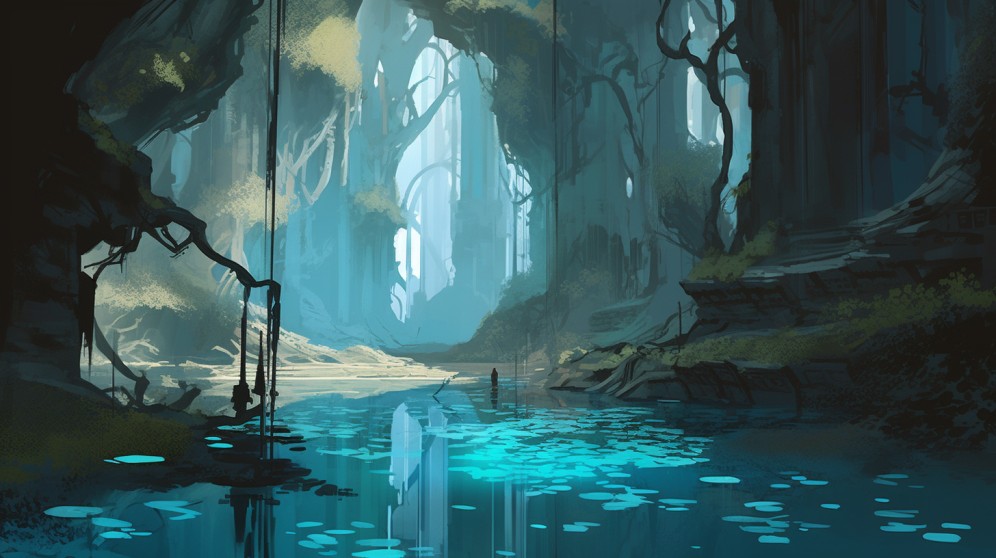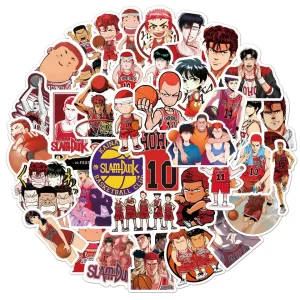Fetch lands are a specific category of land cards in MTG that allow players to sacrifice them and search their library for another land card, often with a specific set of characteristics. They play a crucial role in mana fixing and deck thinning, ensuring that players have access to the right colors of mana when needed.
What Are Fetch Lands?
Since their inception, fetch lands have been a hot topic among Magic The Gathering players. I remember attending my first Friday Night Magic event, where someone attempted to explain the concept of fetch lands and their significance. I didn’t fully grasp the concept at the time, but now, years later, I’m here to share everything I wish I had known about fetch lands when I first started playing.
Fetch lands are a type of land card that can be sacrificed to search for and retrieve another land from a player’s deck. While there are more than 25 lands in Magic The Gathering classified as fetch lands, only 10 of them are commonly referred to as “Fetch Lands” by players.
This information might seem confusing to new Magic The Gathering players, but learning just a few essential aspects of fetch lands will quickly turn you into an expert.

Having a solid understanding of fetch lands and their mechanics is crucial since it’s nearly impossible to play Magic The Gathering without encountering them. The key to understanding fetch lands lies in their name.
All fetch lands, as the name implies, “fetch” another land from your deck. Regardless of the specific fetch land being discussed, the primary function of a fetch land in Magic The Gathering is to search for and retrieve another land from your deck.
Each MTG fetchland has an associated cost for activating its ability, which typically involves sacrificing the fetch land and sending it to the graveyard. Additionally, fetch lands have various costs and restrictions that determine the type and quantity of lands they can fetch from your deck.
Some fetch lands are more suitable for specific formats than others, but there are 10 particular fetch lands that every Magic player should be aware of.
The Original Ten Fetch Lands
The first ten fetch lands were introduced in the Onslaught and Zendikar blocks. They are often considered the most powerful and popular fetch lands in MTG. Here is a list of these essential fetch lands:
- Flooded Strand – Sacrifice to search for an Island or Plains.
- Polluted Delta – Sacrifice to search for an Island or Swamp.
- Bloodstained Mire – Sacrifice to search for a Swamp or Mountain.
- Wooded Foothills – Sacrifice to search for a Mountain or Forest.
- Windswept Heath – Sacrifice to search for a Plains or Forest.
- Marsh Flats – Sacrifice to search for a Plains or Swamp.
- Scalding Tarn – Sacrifice to search for an Island or Mountain.
- Verdant Catacombs – Sacrifice to search for a Swamp or Forest.
- Arid Mesa – Sacrifice to search for a Plains or Mountain.
- Misty Rainforest – Sacrifice to search for an Island or Forest.

The Allied Fetch Lands
The Onslaught set, released in 2002, introduced five new fetch lands:
| Fetch Land Name | Fetchable Land Types | Mana Association |
|---|---|---|
| Polluted Delta | Island, Swamp | Dimir (Blue, Black) |
| Bloodstained Mire | Swamp, Mountain | Rakdos (Black, Red) |
| Wooded Foothills | Mountain, Forest | Gruul (Red, Green) |
| Windswept Heath | Forest, Plains | Selesnya (Green, White) |
| Flooded Strand | Plains, Island | Azorius (White, Blue) |
These fetch lands enter the battlefield untapped, but require you to pay 1 life to sacrifice and activate them. Furthermore, they can only fetch “allied color” lands from their designated pair. In Magic The Gathering, allied colors refer to color pairings that are naturally synergistic with one another, such as red and black (also known as “Rakdos”).
For example, Bloodstained Mire’s ability:
Tap, Pay 1 life, Sacrifice Bloodstained Mire: Search your library for a Swamp or Mountain card, put it onto the battlefield, then shuffle.
The fact that fetched lands enter the battlefield untapped offers a considerable advantage!
At first glance, you may question the logic behind spending 1 life to fetch a land. However, in specific scenarios, this trade-off can be highly advantageous. Fetch lands can be a game-changer when using a multi-colored mana base and struggling to draw the appropriate land colors from your deck.
Consider a situation where you cannot access 2 of the 3 colors of mana required for your deck to function effectively; this predicament could be particularly detrimental during the early stages of the game.
So, which option is more favorable? Sacrificing 1 life to fetch the necessary mana and immediately casting spells to challenge your opponent, or being immobilized for several turns, providing your opponent with ample opportunity to fortify their defense?
Enemy Fetch Lands
The initial 5 fetch lands were incredibly popular among Magic: The Gathering players, prompting Wizards of the Coast to introduce 5 more in the 2009 “Zendikar” set.
| Fetch Land Name | Fetchable Land Types | Mana Association |
|---|---|---|
| Marsh Flats | Plains, Swamp | Orzhov (White, Black) |
| Scalding Tarn | Island, Mountain | Izzet (Blue, Red) |
| Misty Rainforest | Island, Forest | Simic (Blue, Green) |
| Verdant Catacombs | Forest, Swamp | Golgari (Green, Black) |
| Arid Mesa | Plains, Mountain | Boros (White, Red) |
These opposing-color “fetch lands” completed the set, representing every two-color combination in Magic.
Two-color combinations in Magic: The Gathering are often identified by the symbol or the name of the “Ravnica Guild” sharing the color identity of those two colors. Opposing-color pairings are situated across from each other on Magic’s “Color Pie,” while allied colors are adjacent.
These lands not only provide players with enhanced control over their mana bases, but they also grant multicolor decks considerable extra advantages.
While some might contend that fetch lands don’t offer inherent benefits unless a deck’s mana structure necessitates them, it’s tough to overlook their adaptability across various scenarios.
In spite of their steep price, fetch lands are exceptionally versatile in decks designed around specific game plans.
It’s worth noting that while the 10 fetch lands previously mentioned are generally the ones Magic players refer to when talking about “fetch lands,” although they are not the only fetch lands in the game.
Other Notable Fetch Lands
Beyond the original ten, several other fetch lands have been introduced in MTG over the years. Some noteworthy examples include:
- Fabled Passage – This versatile fetch land allows you to search for a basic land card and put it onto the battlefield tapped. If you control four or more lands, the fetched land enters the battlefield untapped instead.
- Prismatic Vista – Similar to Fabled Passage, Prismatic Vista allows you to search for a basic land card, which enters the battlefield untapped. However, it does not have the condition of controlling four or more lands.
- Evolving Wilds and Terramorphic Expanse – These fetch lands have identical abilities, allowing you to search for a basic land card, which enters the battlefield tapped. They are particularly useful in budget decks and limited formats.
- Ash Barrens – This fetch land has a unique cycling ability, which lets you discard it and search for a basic land card, revealing it and putting it into your hand. It can also be played as a colorless mana source.

What Makes Fetch Lands So Valuable? Interactions
Fetch lands offer strategic advantages and have unique interactions with other cards in MTG. Some important rules and interactions to consider are:
Fetching Duals
Consider these lands and their type line between the illustration and text box:
You may notice that Flooded Strand is labeled “Land,” Hallowed Fountain reads “Land – Plains Island,” and the Island displays “Basic Land – Island.”
Since Flooded Strand enables you to search your library for a Plains or an Island without specifying basic or nonbasic, you can fetch an Island or the Hallowed Fountain shockland, as it possesses both Plains and Island as its subtypes. If you have the OG dual lands, you could also fetch them, for example Volcanic Island.

Additionally, you could fetch Watery Grave, Temple Garden, Godless Shrine, Steam Vents, Sacred Foundry, or Breeding Pool, as each of them has either Plains or Island as a basic land type.
To have shocklands enter the battlefield untapped, you would still need to pay two life, as their enter-the-battlefield (ETB) condition still applies. Fetch lands don’t indicate whether the fetched cards enter tapped or untapped, so that’s determined by the fetched card’s conditions.
Shuffle Effect
The “shuffle” effect provided by fetch lands can be beneficial. Suppose you’re using Brainstorm, which lets you draw three cards and put two back on top of your library. If you have cards in your hand that won’t be useful in the next couple of turns, you can cast Brainstorm, place the undesirable cards on the top of your library, and then fetch a land.

By doing so, you’ll shuffle and discard the unhelpful cards. Combine this with a few scrying cards, and you’ll gain greater control over your draws.
Graveyard Interactions
Fetch lands can be used as a resource in the graveyard, as they can be returned to the battlefield or hand through various card effects.
Landfall Triggers
Lastly, fetch lands can trigger “landfall” effects multiple times by fetching a land and then placing another land on the battlefield. This can help you rapidly accumulate a significant advantage.
Fetch Land Strategies and Deck Building
Fetch lands can significantly impact your deck’s performance, offering various strategic benefits. Here are some tips for incorporating fetch lands into your deck:
- Dual lands synergy: Pair fetch lands with dual lands that have basic land types, such as shock lands or original dual lands, to maximize your mana-fixing capabilities.
- Multicolor decks: Fetch lands are particularly useful in multicolor decks, as they help ensure you have access to the necessary mana colors.
- Three or more colors: If your deck has three or more colors, consider using a mix of fetch lands and dual lands to create a flexible and efficient mana base.
- Balancing fetch lands and dual lands: While fetch lands are powerful, they should not replace all of your dual lands. Balance your mana base by including both fetch lands and dual lands to avoid over-reliance on fetch effects.
- Life loss consideration: Be aware of the life loss associated with some fetch lands, particularly when paired with shock lands. In aggressive metagames, the life loss can become a significant drawback.
Where to Get Fetch Lands
So, we all know fetch lands are powerful and pricey, but they’re essential for certain formats, right? Now, how can we get them without spending a fortune?

Original Cards
Well, when you’re looking to buy fetch lands, it’s all about being smart with your choices. I’d recommend going for an open marketplace rather than just a single seller. Why? Because with multiple sellers competing, you’re more likely to find a better price. A great example is eBay. By browsing through the listings, you might stumble upon some fantastic deals, especially if a seller has accidentally underpriced something.
TCGPlayer is another open market for Trading Cards Games, including Magic and Pokemon.
Another option worth considering is Amazon. Although there’s no “low listing and bidding,” prices are usually quite competitive, with multiple sellers vying for your attention. And when you factor in shipping costs, you might find that Amazon offers quite affordable prices, at least for older MTG cards.
Proxy MTG Cards
If you want to save money, you can also buy high quality MTG proxy cards. For example, a website called ProxyMTG.com offers very realistic proxy cards for a great price. You can get a set of fetch lands for around $35.
ProxyKing.biz is another popular proxy card website.
Conclusion
Fetch lands are a vital component of many MTG decks, offering strategic advantages through mana fixing, deck thinning, and unique card interactions. By understanding the different types of fetch lands, their rules, and their potential impact on your deck, you can make informed decisions during deck construction and improve your overall gameplay.













